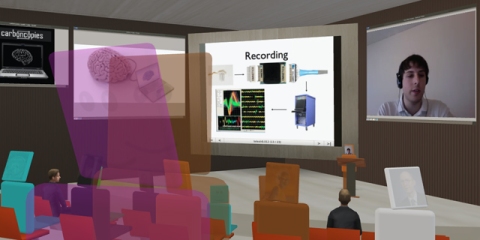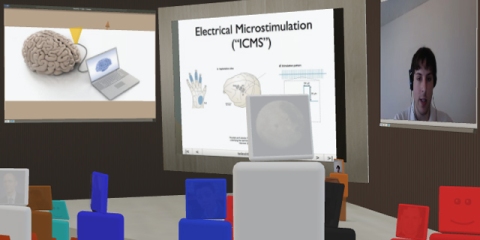Max Hodak gave an ASIM Expert Series talk in Teleplace on “Brain-machine interfacing: current work and future directions” on Sunday October 17.
About 30 participants attended the talk and contributed to the discussion with very interesting questions and comments. For those who could not attend we have recorded everything (talk, Q/A and discussion) on video. There are 4 different videos on blip.tv:
VIDEO 1: 600×400 resolution, 57 min
VIDEO 2: 600×400 resolution, 58 min, taken (mostly) from a fixed point of view
VIDEO A: 360×240 resolution, 61 min, recorded by Phillip Galinsky
VIDEO B: 600×400 resolution, 68 min, recorded by Next Dila Dreamhacker
NOTES: To download the source .mp4 video files from blip.tv, open the “Files and Links” box.
Abstract: Fluid, two-way brain-machine interfacing represents one of the greatest challenges of modern bioengineering. It offers the potential to restore movement and speech to the locked-in, and ultimately allow us as humans to expand far beyond the biological limits we’re encased in now. But, there’s a long road ahead. Today, noninvasive BMIs are largely useless as practical devices and invasive BMIs are critically limited, though progress is being made everyday. Microwire array recording is used all over the world to decode motor intent out of cortex to drive robotic actuators and software controls. Electrical intracortical microstimulation is used to “write” information to the brain, and optogenetic methods promise to make that easier and safer. Monkey models can perform tasks from controlling a walking robot to feeding themselves with a 7-DOF robotic arm. Before we’ll be able to make the jump to humans, biocompatibility of electrodes and limited channel counts are significant hurdles that will need to be crossed. These technologies are still in their infancy, but they’re a huge opportunity in science for those motivated to help bring them through to maturity.
Max Hodak is a scientist-in-training working on brain-machine interfacing at Duke. He founded Quantios to use computing, machine learning to improve life. American, French dual citizen.
Teleplace is one of the best 3D applications for telework, online meetings, group collaboration, and e-learning in a virtual 3D environment (v-learning).







You must be logged in to post a comment.